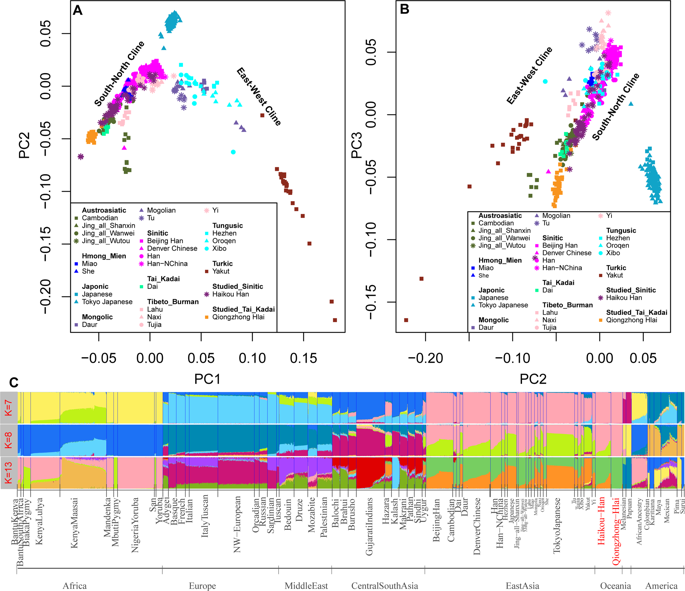当前位置:
X-MOL 学术
›
Eur. J. Hum. Genet.
›
论文详情
Our official English website, www.x-mol.net, welcomes your
feedback! (Note: you will need to create a separate account there.)
Inferring the population history of Tai-Kadai-speaking people and southernmost Han Chinese on Hainan Island by genome-wide array genotyping.
European Journal of Human Genetics ( IF 3.7 ) Pub Date : 2020-03-02 , DOI: 10.1038/s41431-020-0599-7 Guanglin He 1, 2 , Zheng Wang 1 , Jianxin Guo 2 , Mengge Wang 1 , Xing Zou 1 , Renkuan Tang 3 , Jing Liu 1 , Han Zhang 4 , Yingxiang Li 2 , Rong Hu 2 , Lan-Hai Wei 2 , Gang Chen 5 , Chuan-Chao Wang 2 , Yiping Hou 1
European Journal of Human Genetics ( IF 3.7 ) Pub Date : 2020-03-02 , DOI: 10.1038/s41431-020-0599-7 Guanglin He 1, 2 , Zheng Wang 1 , Jianxin Guo 2 , Mengge Wang 1 , Xing Zou 1 , Renkuan Tang 3 , Jing Liu 1 , Han Zhang 4 , Yingxiang Li 2 , Rong Hu 2 , Lan-Hai Wei 2 , Gang Chen 5 , Chuan-Chao Wang 2 , Yiping Hou 1
Affiliation

|
Hainan Island, located between East Asia and Southeast Asia, represents an ideal region for the study of the genetic architecture of geographically isolated populations. However, the genetic structure and demographic history of the indigenous Tai-Kadai-speaking Hlai people and recent expanded southernmost Han Chinese on this island are poorly characterized due to a lack of genetic data. Thus, we collected and genotyped 36 Qiongzhong Hlai and 48 Haikou Han individuals at 497,637 single nucleotide polymorphisms (SNPs). We applied principal component analysis, ADMIXTURE, symmetrical D-statistics, admixture-f3 statistics, qpWave, and qpAdm analysis to infer the population history. Our results revealed the East Asian populations are characterized by a north-south genetic cline with Hlai at the southernmost end. We have not detected recent gene flow from neighboring populations into Hlai, therefore, we used Hlai as an unadmixed proxy to model the admixture history of mainland Tai-Kadai-speaking populations and southern Han Chinese. The mainland Tai-Kadai-speaking populations are suggested deriving a larger number of their ancestry from Hlai-related lineage, but also having admixture from South Asian-related or other neighboring populations. The Hlai group is also suggested to contribute about half of the ancestry to Han Chinese in Hainan. The complex patterns of genetic structure in East Asia were shaped via language categories, geographical boundaries, and large southward population movements with language dispersal and agriculture propagation.
中文翻译:

通过全基因组阵列基因分型推断海南岛讲泰语和最南端汉族的人口历史。
海南岛位于东亚和东南亚之间,是研究地理隔离种群遗传结构的理想区域。然而,由于缺乏遗传数据,当地说泰语-卡代语的 Hlai 人和最近在该岛上扩张的最南端的汉族人的遗传结构和人口历史特征很差。因此,我们在 497,637 个单核苷酸多态性 (SNP) 上收集并基因分型了 36 个琼中莱人和 48 个海口汉族个体。我们应用主成分分析、ADMIXTURE、对称 D 统计、admixture-f3 统计、qpWave 和 qpAdm 分析来推断种群历史。我们的研究结果表明,东亚人群的特征是南北向遗传,最南端是 Hlai。我们没有检测到最近从邻近人群流入 Hlai 的基因,因此,我们使用 Hlai 作为未混合的代理来模拟大陆讲泰语-Kadai 的人群和南方汉族人的混合历史。建议大陆讲泰语的人口从与 Hlai 相关的血统中获得更多的血统,但也有来自南亚相关或其他邻近人口的混合物。还建议Hlai集团贡献海南汉族大约一半的血统。东亚复杂的遗传结构模式是通过语言类别、地理边界以及随着语言传播和农业传播而向南的大规模人口移动形成的。我们使用 Hlai 作为未混合的代理来模拟大陆讲泰语 - 卡代语的人群和南方汉族人的混合历史。建议大陆讲泰语的人口从与 Hlai 相关的血统中获得更多的血统,但也有来自南亚相关或其他邻近人口的混合物。还建议Hlai集团贡献大约一半的海南汉族血统。东亚复杂的遗传结构模式是通过语言类别、地理边界以及随着语言传播和农业传播而向南的大规模人口移动形成的。我们使用 Hlai 作为未混合的代理来模拟大陆讲泰语 - 卡代语的人群和南方汉族人的混合历史。大陆讲泰语的人口被建议从与 Hlai 相关的血统中获得更多的血统,但也有来自南亚相关或其他邻近人群的混合物。还建议Hlai集团贡献大约一半的海南汉族血统。东亚复杂的遗传结构模式是通过语言类别、地理边界以及随着语言传播和农业传播而向南的大规模人口移动形成的。但也有来自南亚相关或其他邻近人群的混合物。还建议Hlai集团贡献海南汉族大约一半的血统。东亚复杂的遗传结构模式是通过语言类别、地理边界以及随着语言传播和农业传播而向南的大规模人口移动形成的。但也有来自南亚相关或其他邻近人群的混合物。还建议Hlai集团贡献大约一半的海南汉族血统。东亚复杂的遗传结构模式是通过语言类别、地理边界以及随着语言传播和农业传播而向南的大规模人口移动形成的。
更新日期:2020-04-24
中文翻译:

通过全基因组阵列基因分型推断海南岛讲泰语和最南端汉族的人口历史。
海南岛位于东亚和东南亚之间,是研究地理隔离种群遗传结构的理想区域。然而,由于缺乏遗传数据,当地说泰语-卡代语的 Hlai 人和最近在该岛上扩张的最南端的汉族人的遗传结构和人口历史特征很差。因此,我们在 497,637 个单核苷酸多态性 (SNP) 上收集并基因分型了 36 个琼中莱人和 48 个海口汉族个体。我们应用主成分分析、ADMIXTURE、对称 D 统计、admixture-f3 统计、qpWave 和 qpAdm 分析来推断种群历史。我们的研究结果表明,东亚人群的特征是南北向遗传,最南端是 Hlai。我们没有检测到最近从邻近人群流入 Hlai 的基因,因此,我们使用 Hlai 作为未混合的代理来模拟大陆讲泰语-Kadai 的人群和南方汉族人的混合历史。建议大陆讲泰语的人口从与 Hlai 相关的血统中获得更多的血统,但也有来自南亚相关或其他邻近人口的混合物。还建议Hlai集团贡献海南汉族大约一半的血统。东亚复杂的遗传结构模式是通过语言类别、地理边界以及随着语言传播和农业传播而向南的大规模人口移动形成的。我们使用 Hlai 作为未混合的代理来模拟大陆讲泰语 - 卡代语的人群和南方汉族人的混合历史。建议大陆讲泰语的人口从与 Hlai 相关的血统中获得更多的血统,但也有来自南亚相关或其他邻近人口的混合物。还建议Hlai集团贡献大约一半的海南汉族血统。东亚复杂的遗传结构模式是通过语言类别、地理边界以及随着语言传播和农业传播而向南的大规模人口移动形成的。我们使用 Hlai 作为未混合的代理来模拟大陆讲泰语 - 卡代语的人群和南方汉族人的混合历史。大陆讲泰语的人口被建议从与 Hlai 相关的血统中获得更多的血统,但也有来自南亚相关或其他邻近人群的混合物。还建议Hlai集团贡献大约一半的海南汉族血统。东亚复杂的遗传结构模式是通过语言类别、地理边界以及随着语言传播和农业传播而向南的大规模人口移动形成的。但也有来自南亚相关或其他邻近人群的混合物。还建议Hlai集团贡献海南汉族大约一半的血统。东亚复杂的遗传结构模式是通过语言类别、地理边界以及随着语言传播和农业传播而向南的大规模人口移动形成的。但也有来自南亚相关或其他邻近人群的混合物。还建议Hlai集团贡献大约一半的海南汉族血统。东亚复杂的遗传结构模式是通过语言类别、地理边界以及随着语言传播和农业传播而向南的大规模人口移动形成的。











































 京公网安备 11010802027423号
京公网安备 11010802027423号